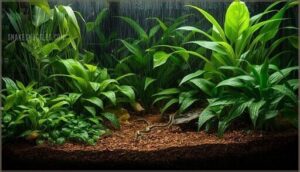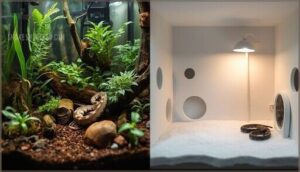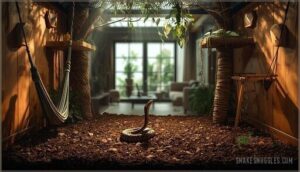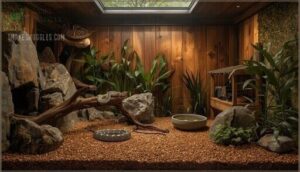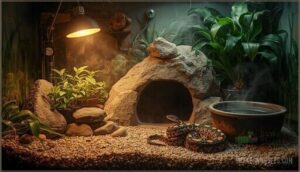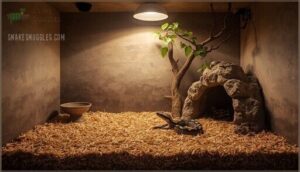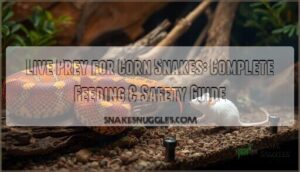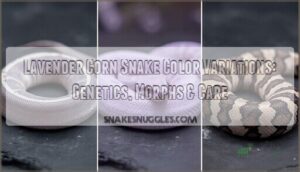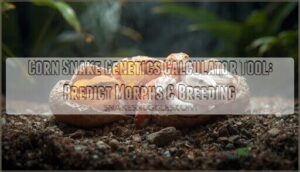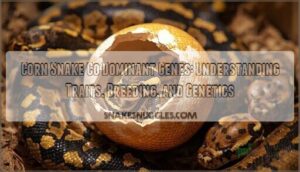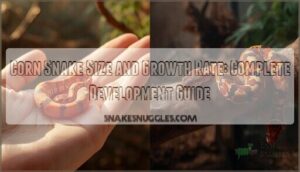This site is supported by our readers. We may earn a commission, at no cost to you, if you purchase through links.
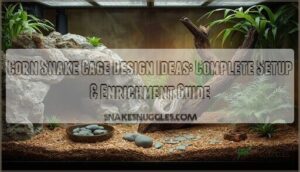
The difference between a stressed snake and a thriving one often comes down to layout choices you make in the first week. Smart cage design balances your snake’s need for security with your ability to maintain proper conditions.
Whether you’re setting up your first enclosure or upgrading an existing one, the right combination of space, materials, and enrichment creates an environment where your corn snake naturally exhibits healthy behaviors.
Table Of Contents
- Key Takeaways
- Essential Corn Snake Cage Size and Materials
- Creative Corn Snake Cage Layout Ideas
- Decor and Accessories for Enrichment
- Heating, Lighting, and Humidity Solutions
- Substrate and Maintenance Tips for Healthy Enclosures
- Frequently Asked Questions (FAQs)
- How do you decorate a corn snake enclosure?
- Do corn snakes need an enclosure?
- Do corn snakes need cage accessories?
- How do I choose the best corn snake enclosure setup?
- What size cage do corn snakes need?
- How do you keep a corn snake in a cage?
- Can corn snakes escape through small gaps?
- How often should decorations be rearranged?
- What temperatures are safe during winter months?
- Do corn snakes need a separate feeding enclosure?
- Conclusion
Key Takeaways
- Adult corn snakes require a minimum enclosure of 48″L x 24″W x 24″H with proper temperature gradients (warm side 85-90°F, cool side 75-82°F) and at least two hides to prevent stress and support natural thermoregulation behaviors.
- Enclosure material choice significantly impacts maintenance and performance—PVC retains heat 20% longer than glass and lasts 15-20 years, while proper ventilation with strategically placed vents maintains 40-60% humidity without creating stagnant air.
- Naturalistic setups with climbing structures, multiple levels, and enrichment features increase snake activity by 31-58% compared to minimalist designs, though bioactive systems with live plants and cleanup crews reduce maintenance by 80%.
- Regular substrate maintenance (daily spot-cleaning, deep cleaning every 4-6 weeks) and proper airflow prevent mold growth and scale infections by 60-65%, while UVB lighting (5-6% T5 HO bulbs positioned 12-18 inches away) supports immune function and vitamin D3 production.
Essential Corn Snake Cage Size and Materials
The right cage size and materials make all the difference in keeping your corn snake healthy and comfortable. You’ll need to factor in dimensions that match your snake’s age and size, then choose materials that hold heat and humidity properly.
Let’s look at the key factors that’ll set up your corn snake for success.
Minimum and Ideal Enclosure Dimensions
Space requirements shape your corn snake’s health and happiness. Adults need at least 48″L x 24″W x 24″H—that’s a standard 4′ x 2′ x 2′ enclosure setup. Hatchlings start in 10-gallon tanks, then juveniles move to 20-gallon long terrariums.
A simple scaling formula: enclosure length should match your snake length, with width at half that measure and adequate enclosure depth for climbing. Understanding the ideal enclosure size guidelines is vital for creating a suitable environment.
Glass Vs. Plastic Vs. Wooden Enclosures
Once you’ve settled on dimensions, enclosure materials become your next decision. Glass enclosures offer crystal-clear visibility but lose heat 30–40% faster than other options. PVC—a popular plastic enclosure choice—retains warmth 20% longer and weighs about half as much, making it easier to move. Wooden enclosures deliver excellent heat retention and insulation materials performance, though moisture control requires sealed surfaces to prevent warping.
Material costs average $120–$150 for glass, $200–$250 for PVC, and $180–$220 for wood. Enclosure durability favors PVC, lasting 15–20 years with minimal upkeep.
For proper reptile care, understanding heat retention methods is essential for creating a suitable environment.
Ventilation and Security Features
Your chosen material sets the foundation, but ventilation systems and secure lids determine long-term success. Proper airflow management prevents stagnant air while maintaining 40–60% humidity. Two to three 5-inch by 3-inch vents positioned at upper and lower levels create ideal circulation. Escape prevention demands four locking clamps on glass tanks—gaps as small as a corn snake’s snout enable escapes. Mesh top benefits include heat retention with adequate air exchange.
- Strategic vent placement balances airflow with temperature stability
- Metal mesh screens resist penetration while supporting humidity control
- Four-point locking clamps eliminate escape risks on large glass enclosures
- Front-opening latches require secondary locks or metal pins for security
- Cord holes sealed to pencil-diameter tolerance prevent juvenile escapes
Creative Corn Snake Cage Layout Ideas
Your corn snake’s enclosure can be simple or complex, depending on your style and your snake’s needs. Some setups lean into natural beauty with plants and layers, while others keep things clean and functional.
Here are three popular approaches that work well for corn snakes.
Bioactive Setups With Live Plants
A bioactive setup transforms your corn snake’s enclosure into a living ecosystem. You’ll blend 40% topsoil, 40% coconut fiber, and 20% play sand for substrate, then introduce microfauna like springtails and isopods to handle waste naturally.
Plant species selection matters—pothos, snake plants, and parlor palms thrive in vivariums with 65–75% humidity.
This naturalistic enclosure creates ecological balance while reducing vivarium maintenance by 80%.
Naturalistic Vs. Minimalist Designs
Your corn snake habitat will fall somewhere between two design philosophies. Naturalistic enclosures recreate wild environments with live plants, leaf litter, and spatial complexity—studies show snakes in these setups display 31.7% more active behavior and 58% increased exploration.
Minimalist designs use artificial hides and simple substrate but still meet thermal needs if managed well.
The choice hinges on your priorities: ecological balance and enrichment benefits versus straightforward maintenance and vivarium simplicity.
Vertical Space and Multi-Level Enclosures
Height unlocks new dimensions of welfare—corn snakes in taller enclosures show 37% more vertical climbing and 22% higher exploratory activity. Multi-level designs optimize space and diversify behavior without expanding footprint.
Zen Habitats’ 4x2x4 enclosures double vertical space over standard tanks, supporting three distinct levels with reinforced shelving.
- Climbing structures like wrapped perches and textured branches improve grip stability by 45%
- Hammock platforms and elevated hides increase active periods by 20%
- Bridge installations and multi-tiered shelves add 25% more usable area while reducing ground clutter
Decor and Accessories for Enrichment
Your corn snake needs more than just a box with substrate. Decor and accessories create enrichment, support natural behaviors, and make the enclosure safer.
Here’s what you should consider adding to your setup.
Hides, Hammocks, and Climbing Structures
Think of secure hides as your snake’s safe room—without them, stress skyrockets. You’ll want at least two hides: one on the warm side, one on the cool. This setup lets your corn snake thermoregulate without feeling exposed.
Add a hammock made from breathable material for elevated basking, and your snake will use vertical space more often. Climbing structures like branches or perches boost activity and reduce boredom-related behaviors.
Mix it up with enrichment variety—different textures, heights, and locations throughout the enclosure decor keep things interesting and support natural movement patterns. Good perch placement near heat sources helps with climbing safety while maintaining proper temperatures.
Safe Use of Rocks, Logs, and Driftwood
Natural materials like rocks, logs, and driftwood transform enclosure decor into something your snake will actually use. Stick with slate, quartz, or granite for rock selection—limestone and sandstone mess with pH. For logs, hardwoods like oak and maple work best, but avoid pine or cedar since they leak harmful resins.
Always sterilize: boil rocks for 10–15 minutes, bake logs at 250°F for two hours. Driftwood safety means soaking for 48–72 hours to remove tannins. Monthly decor disinfection with reptile-safe cleaners keeps your substrate and setup healthy long-term.
Choosing Live Vs. Fake Plants
Both options work, but they serve different roles. Live plants boost humidity by 10–20%, helping your snake shed cleanly and creating a more stable environment. You’ll need to water them regularly and watch for root damage—snakes flatten about 40% of unprotected plants.
Fake plants require zero upkeep and last years, but you’ll mist more often and disinfect monthly. Plant toxicity matters with live species like Dieffenbachia.
For enrichment value and aesthetic appeal, mixing both gives you humidity control without constant replanting.
Water Bowl Placement and Size
Your water bowl isn’t just for drinking—it’s a humidity regulator. A 6–8 inch ceramic bowl works best for adults, offering stability and tip resistance. Bowl material matters: ceramic beats lightweight plastic for spill prevention.
Place it on the warm side to boost humidity by 5–10%, or on the cool side to reduce refills.
Clean every 2–3 days using reptile-safe disinfectant—biofilm forms within 48 hours.
Heating, Lighting, and Humidity Solutions
Your corn snake needs the right temperature, lighting, and humidity to stay healthy. Getting these three factors right isn’t complicated, but each plays a different role in your snake’s daily life.
Here’s how to set up each element so your enclosure works the way it should.
Creating a Proper Temperature Gradient
Your corn snake needs a thermal gradient to thrive—that means a warm end between 85°F and 90°F for basking and digestion, and a cool side around 75°F to 82°F for rest. This gradient creation lets your snake thermoregulate naturally by moving between zones.
Use digital probe thermometers on both sides, not just near heat sources, and always pair heating equipment with thermostat settings to avoid dangerous spikes above 92°F.
Recommended Heating Equipment
Once you know what temperature gradient you want, you need the right tools. Halogen flood bulbs work well for basking surfaces around 90°F, while heat mats (paired with thermostats) warm substrates between 80–88°F.
Here’s your heating equipment checklist:
- Dual 90W halogen PAR38 bulbs in ceramic sockets for even heat distribution
- Heat mat covering no more than one-third of the floor area
- Digital thermostat to regulate within ±1°C and prevent overheating
- Ceramic heat emitters or deep heat projectors for maintaining nighttime warmth without light
Always position bulbs 8–13 inches above mesh tops and test temps for one week before introducing your snake. Heat rocks aren’t safe—they frequently overheat beyond 150°F.
UVB Lighting Options and Placement
UVB lighting is essential for boosting vitamin D3 levels and supporting immune function in snakes. A 5–6% T5 High Output tube, such as the Zoo Med Reptisun 5.0 or Arcadia Forest 6%, positioned 12–18 inches above the basking spot, delivers a safe UVI of 2.0–3.0.
| Component | Specification |
|---|---|
| Bulb type | T5 HO 5–6% UVB |
| Distance from snake | 12–18 inches |
| Coverage area | Half the enclosure length |
To set up the UVB lighting, mount the fixture horizontally along one side of the enclosure to create a gradient. Run it on a 10–12 hour day-night cycle, synchronized with your basking lamp. Replace the bulbs every 12 months, as UVI measurement, not brightness, confirms output. Albino morphs require lower intensity, so provide extra shade. Proper exposure duration and accurate placement are crucial for maximizing the benefits of UVB.
Humidity Control and Monitoring Tools
Now that you’ve set up lighting, maintaining the right humidity levels keeps your snake healthy through every shed cycle. Aim for 40–60% humidity, spiking to 70% during shedding.
Here’s what you need:
- Digital hygrometers – Get ±1–3% accuracy instead of cheap analog models that can be off by 30%. Place one mid-enclosure and another inside the humid hide.
- Fogger systems – Ultrasonic foggers like the Repti Zoo deliver adjustable mist output with large reservoirs, maintaining steady humidity without constant refills.
- Misting schedules – Spray distilled water twice daily to boost humidity 10–15% for about six hours. Automate with programmable systems like MistKing.
- Humidity control methods – Position water bowls near heat sources for natural evaporation. Use moisture-retentive substrates like cypress mulch to hold humidity 20–30% higher than aspen.
Check readings weekly and adjust ventilation if levels climb above 80% for more than three days—that’s when scale rot risk jumps 40%.
Substrate and Maintenance Tips for Healthy Enclosures
The right substrate keeps your corn snake comfortable and makes cleaning easier. Regular maintenance prevents health issues and keeps the enclosure fresh.
Here’s what works best for substrate choices and care routines.
Best Substrate Choices for Corn Snakes
Your substrate choice shapes both humidity regulation and burrowing behavior. Aspen alternatives like coconut fiber or cypress mulch excel at maintaining 65-75% humidity, while aspen shavings work best under 60%. Bioactive benefits emerge when using naturalistic soil mixes with cleanup crews.
Here’s how ideal substrate options compare for substrate safety and enrichment:
| Substrate Type | Humidity Range | Best For |
|---|---|---|
| Aspen shavings | Below 60% | Low-maintenance, budget-friendly setups |
| Coconut fiber | 65-75% | Moderate humidity, burrowing snakes |
| Cypress mulch | 65-75% | Mold resistance, natural look |
| Naturalistic soil mix | 65-75% | Bioactive setups, deep burrowing |
| Paper towels | Variable | Quarantine, temporary housing |
Choosing appropriate substrate options means matching your snake’s needs with your maintenance schedule and humidity goals.
Spot-Cleaning and Deep Cleaning Routines
Daily spot cleaning removes waste and keeps odors at bay. Use scoops or forceps to pull out feces and shed skin—most keepers do this every day.
Deep cleaning every 4–6 weeks means replacing substrate, disinfecting surfaces, and scrubbing water bowls. Reptile-safe disinfectants reduce bacterial contamination by over 60%. Rinse everything thoroughly and let it dry for 30–60 minutes.
This cleaning routine cuts scale infections by 65% and keeps your snake healthier long-term.
Preventing Mold and Maintaining Airflow
Good airflow stops mold before it starts. Without proper ventilation, humidity spikes and fungal growth explodes—poor ventilation raises mold risk by 60%. PVC enclosures resist moisture better than wood. Regular substrate changes every 2–3 weeks reduce mold spores by 80%.
- Install vents on opposite ends — two 5″x3″ vents create natural convection through the enclosure
- Keep humidity between 40–60% — levels above 70% increase fungal growth by 45%
- Use small USB fans — forced airflow cuts stagnant air and boosts circulation by 50%
- Replace moss every 7–10 days — prevents mold colonization in humidity hides
Safe Handling and Feeding Practices
Handle your corn snake with care—your approach affects long-term snake health and behavior. Support two-thirds of the body using proper techniques to prevent injury. Handle adults for 10–20 minutes, two to four times weekly—consistent handling frequency reduces bites by 30%. Watch for rapid tongue flicking or S-posture for stress mitigation.
Feed with tongs to avoid prey-association aggression, offering items 1–1.5 times mid-body width. Wait 48 hours after feeding for post-feeding hygiene and digestion, and always wash hands to prevent Salmonella.
Frequently Asked Questions (FAQs)
How do you decorate a corn snake enclosure?
Picture your corn snake gliding through a miniature forest. Start with theme creation—choose habitat design like natural woodland or desert. Add hides, artificial plants, and safe materials like cork bark.
Layer enrichment through climbing branches and varied decor for exploration.
Do corn snakes need an enclosure?
Yes, corn snakes absolutely need an enclosure. They’re skilled escape artists who can squeeze through tiny gaps and climb with ease.
An escape-proof vivarium keeps your snake safe from household hazards like electrical wires and prevents stress-related health issues by maintaining proper temperature and humidity.
Do corn snakes need cage accessories?
Corn snakes absolutely need cage accessories for their well-being. Accessories like hiding spots, climbing structures, water bowls, and plants support natural behaviors, reduce stress, and promote physical health.
Environmental enrichment greatly improves cognitive function and overall welfare in captive snakes.
How do I choose the best corn snake enclosure setup?
Selecting a suitable snake enclosure setup starts with space—opt for at least 48x24x24 inches.
Match enclosure materials like glass, PVC, or sealed wood to your humidity goals.
Prioritize snake behavior by adding climbing structures and hides for environmental enrichment and habitat design optimization.
What size cage do corn snakes need?
Adult corn snakes need enclosures that are at least 48 inches long, 24 inches wide, and 24 inches high—that’s around 40 gallons.
Hatchlings start in 10-gallon tanks, while juveniles do well in 20-gallon setups until they grow.
How do you keep a corn snake in a cage?
You’ll maintain enclosure security with proper locking lids and handle your snake gently using calm scooping motions.
Feed pre-killed prey every 10-14 days for adults, monitor health regularly, and maintain heating and humidity levels consistently to support natural snake behavior.
Can corn snakes escape through small gaps?
Yes, snakes can slip through surprisingly tight spots—it’s like threading a needle with scales. Your corn snake can escape through gaps larger than 10 mm (about thumb-width). Their flexibility and natural instinct to explore crevices make enclosure security critical.
Use sealant materials and proper ventilation covers to create an escapeproof snake enclosure, ensuring safety.
How often should decorations be rearranged?
You can rearrange decor every week or two to introduce novelty and support environmental enrichment without overwhelming your snake.
Watch for behavioral monitoring signs like increased hiding or refusal to eat, which suggest stress from too-frequent habitat modification.
What temperatures are safe during winter months?
During winter, keep your corn snake’s enclosure between 75°F and 82°F during the day, with a basking spot at 88-92°F.
Nighttime temperatures shouldn’t drop below 70°F to prevent cold stress and support proper thermoregulation through your thermal gradient.
Do corn snakes need a separate feeding enclosure?
Separate feeding containers aren’t required, but they help reduce feeding aggression and impaction risks from substrate ingestion.
Expert opinions vary—some prefer feeding in the corn snake enclosure to minimize handling stress and avoid conditioned response issues during routine care.
Conclusion
The devil’s in the details for corn snake cage design ideas—overlook humidity zones or hide placement, and your snake pays the price. Your layout choices directly shape feeding confidence, shedding success, and stress levels.
Start with proper dimensions and heat gradients, then layer in climbing branches and dual hides.
A thriving corn snake doesn’t happen by accident; it’s the result of intentional design that mirrors their natural instincts and gives them control over their comfort.
- https://www.reptilecentre.com/blogs/reptile-blog/corn-snake-enclosure-ideas
- https://community.morphmarket.com/t/corn-snake-care-guide/39834
- https://inkbird.com/blogs/aquarium-terrarium/corn-snake-care-guide
- https://talis-us.com/blogs/news/corn-snake-heat-mat-temperature-guide
- https://reptilinks.com/blogs/news/corn-snake-care-guide

